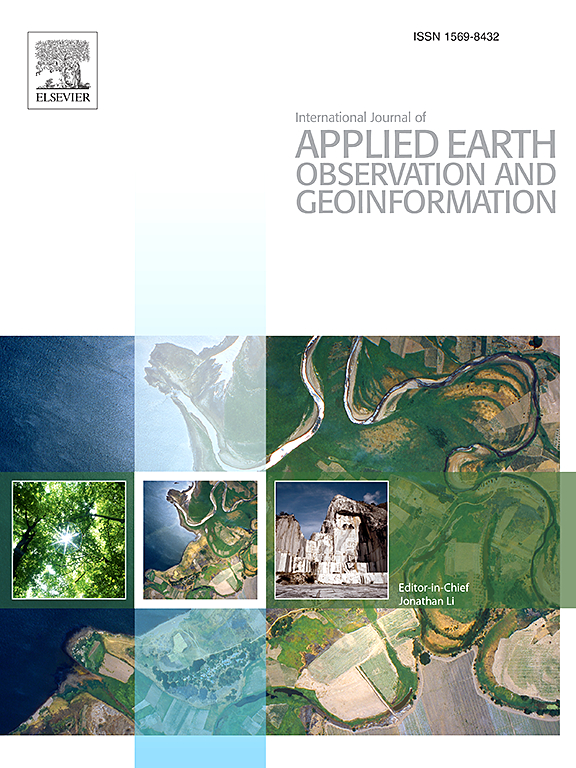评估okavango河流域豆科作物的土地适宜性:多标准和机器学习方法
IF 7.6
Q1 REMOTE SENSING
International journal of applied earth observation and geoinformation : ITC journal
Pub Date : 2024-12-01
DOI:10.1016/j.jag.2024.104284
引用次数: 0
摘要
本研究旨在建立一个模型,以确定在纳米比亚东部卡万戈地区的奥卡万戈河流域适合种植太阳麻(Crotalaria juncea)和鸽豆(Cajanus cajan)的土地。采用Random Forest、Extra Trees、Gradient Boosting、XGBoost和多元回归分析等先进的基于树的集成学习模型来提高分析精度。Random Forest和XGboost模型的准确率分别为0.97和0.96,表现出了优异的性能。此外,本研究提出了一种创新的方法,将主客观分析方法相结合,这是一种相互独立的分析方法。主观成分的分析采用多准则决策-层次分析法(MCDM-AHP)。另一方面,目标组件使用基于树的学习算法支持的数据驱动的多变量方法。考虑了22个变量,包括气候条件、水文地貌特征、土壤特征、植被模式和社会经济因素。这些变量对确定所选豆科作物的最适宜种植区域起着至关重要的作用。MCDM-AHP方法利用专家评价对变量的重要性进行排序,确定水源、坡度和土壤性质为关键因素。适宜性作图分析显示,17.63%的面积适合种植这两种豆科植物,62.77%的面积适宜种植,10%的面积不适宜种植,9.59%的面积不适宜种植。根据数据驱动的方法,土壤肥力和氮含量成为土地适宜性的关键决定因素。这对于在改善土壤质量和确保粮食安全方面发挥核心作用的固氮豆科作物,如太阳麻和鸽豆,尤其重要。本文章由计算机程序翻译,如有差异,请以英文原文为准。
Assessing land suitability for leguminous crops in the okavango river basin: A multicriteria and machine learning approach
This study aimed to create a model to identify land suitable for growing sunn hemp (Crotalaria juncea) and pigeon pea (Cajanus cajan) in the Okavango River basin of the Kavango East region of Namibia. Advanced tree-based ensemble learning models, including Random Forest, Extra Trees, Gradient Boosting, XGBoost and multivariate regression analysis , were employed to enhance analytical accuracy. The Random Forest and XGboost models exhibited outstanding performance, as evidenced by their respective accuracy values of 0.97 and 0.96. In addition, this study proposed an innovative approach through the integration of subjective and objective analytical methods, which are independent of one another. The subjective component of the analysis employed a Multi-Criteria Decision Making-Analytic Hierarchy Process (MCDM-AHP). On the other hand, the objective component used a data-driven multivariate approach supported by tree-based learning algorithms. Twenty-two variables were considered, encompassing climatic conditions, hydro-geomorphologic features, soil characteristics, vegetation patterns, and socio-economic factors. These variables played a crucial role to identify the most suitable areas for growing the selected leguminous crops. The MCDM-AHP method utilised expert evaluations to rank the importance of variables, identifying water sources, slope, and soil properties as key factors. A suitability mapping analysis revealed that 17.63% of the area was highly suitable and 62.77% moderately suitable, while 10% was less suitable and 9.59% unsuitable for growing these two legumes. According to the data driven methodology, soil fertility and nitrogen content emerged as key determinants for land suitability. This is particularly relevant for nitrogen-fixing leguminous crops such as sunn hemp and pigeon pea, which play a central role in improving soil quality and ensuring food security.
求助全文
通过发布文献求助,成功后即可免费获取论文全文。
去求助
来源期刊

International journal of applied earth observation and geoinformation : ITC journal
Global and Planetary Change, Management, Monitoring, Policy and Law, Earth-Surface Processes, Computers in Earth Sciences
CiteScore
12.00
自引率
0.00%
发文量
0
审稿时长
77 days
期刊介绍:
The International Journal of Applied Earth Observation and Geoinformation publishes original papers that utilize earth observation data for natural resource and environmental inventory and management. These data primarily originate from remote sensing platforms, including satellites and aircraft, supplemented by surface and subsurface measurements. Addressing natural resources such as forests, agricultural land, soils, and water, as well as environmental concerns like biodiversity, land degradation, and hazards, the journal explores conceptual and data-driven approaches. It covers geoinformation themes like capturing, databasing, visualization, interpretation, data quality, and spatial uncertainty.
 求助内容:
求助内容: 应助结果提醒方式:
应助结果提醒方式:


